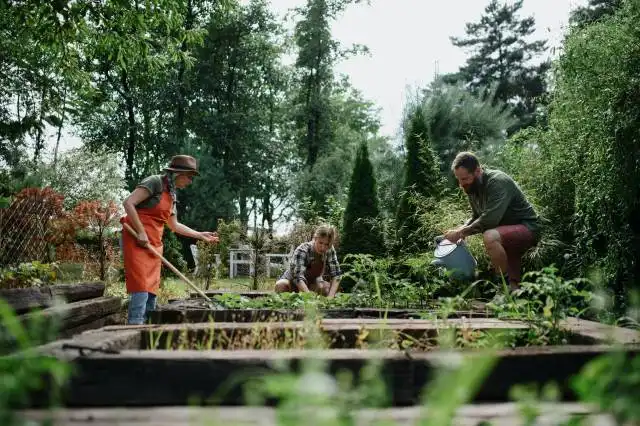Start an Orchard
Become a Curator of Nature's Candy: Start Your Own Profitable Orchard
| Updated


ORCHARD
Embrace the charm of rustic living while turning a juicy profit with an orchard business. This entrepreneurial pursuit involves cultivating a variety of fruit trees, harvesting produce, and selling to farmers’ markets, grocery shops, or directly to consumers. Picture yourself as a cultivator of nature’s candy, delivering vitamin-packed treasures straight from your trees to the taste buds of health-conscious customers. As an orchard owner, you'll cultivate an eye for quality, skills for sustainable farming and the knack for farming market trends.
Jump to Business Plan
RELATED BUSINESS IDEAS
Browse ALL Sustainability & Eco-Friendly Initiatives Business Ideas
Discover Your Perfect Domain
Unlock the door to your online success with our hand-picked selection of premium domain names. Whether you're starting a new venture or rebranding an existing one, the right domain can set the tone for your digital presence. Browse through our curated list, each with its unique potential to enhance your brand's visibility and credibility.
ORCHARD MINI BUSINESS PLAN
This a quick reality check to help you identify the strengths and weaknesses of your business concept before you dive in.
Expected Percent Margin:
- Gross Margin: 40-50%
- Net Profit Margin: 10-20%
Earnings Expectations:
- Daily Earnings: Subject to sales, can range from $100 - $500 in season
- Weekly Earnings: $500 - $2,500 in peak season
- Monthly Earnings: $2,000 - $10,000 subject to seasonality
- Annual Earnings: $20,000 - $120,000 depending on harvest and sales
Actions to Hit Those Numbers:
Setting Up the Orchard:
- Initial Investment: High, at least $50,000 for land, trees, equipment, and labor.
- Orchard Plan: Choose profitable, quick-growing fruit varieties suitable for your climate.
Ongoing Orchard Maintenance:
- Regular Care: Pruning, spraying, pest and disease control, and fertilizing.
- Labor: Seasonal or part-time laborers for cultivation and harvest.
Sales and Marketing:
- Direct Sales: Farm stands, farmers markets, and Community Supported Agriculture (CSA).
- Wholesale: Local grocery stores, schools, and restaurants.
- Value-Add Products: Jams, cider, pies, and other products to boost income.
Cost Control:
- Land: Annual property taxes.
- Utilities and Supplies: Watering and maintenance supplies.
Agriculture Best Practices:
- Sustainable Practices: Organic cultivation, soil conservation, etc.
- Renewing Orchard: Regular planting to ensure productivity as older trees wane.
Please be aware that the startup costs and setup time for an orchard are high and the return on investment can take several years.
Remember, these are rough estimates and actual values will depend heavily on market conditions, types of fruit, efficiency of operations, and how well marketing and sales efforts perform.
NOT WHAT YOU HAD IN MIND? Here are more ideas



Browse ALL Sustainability & Eco-Friendly Initiatives Business Ideas
Grab Your Business Website Name
Before you get caught up in the whirlwind of setting up your business, invest in a domain name. It's a small but significant step that lays the foundation for your brand and makes it easier for customers to find and trust you. Just like you wouldn't build a house without securing the land first, don't build a business without securing your domain name.
"Why? Can't that wait?" Here's why it shouldn't
Step 1: Determine if Starting an Orchard is the Right Endeavor
Breakdown of Startup Expenses
Starting an orchard is a large undertaking and requires a significant investment of both time and money. Before taking the plunge, it is important to understand the startup costs associated with the business. These costs may include purchasing land, building structures, purchasing equipment, and obtaining necessary licenses and permits. Additionally, it is important to factor in the cost of labor, marketing, and other overhead expenses.
Breakdown of Ongoing Expenses
After the initial startup costs, there are ongoing expenses associated with running an orchard. These expenses may include the cost of maintaining the land, fertilizing, pruning, and harvesting the trees, as well as the cost of labor and marketing. Additionally, it is important to factor in the cost of insurance, taxes, and other overhead expenses.
Examples of Ways to Make Money
Once the orchard is up and running, there are a variety of ways to make money. These may include selling the fruit directly to consumers, selling to local markets and restaurants, or even selling the fruit online. Additionally, it may be possible to offer pick-your-own services, or to host events such as weddings or corporate events.
Step 2: Name the Business
When naming a business, it is important to consider the target audience and the message the business is trying to convey. It is also important to make sure the name is unique and not already taken by another business. It is also important to make sure the name is easy to remember and pronounce. Additionally, it is important to consider the future of the business and how the name might evolve with the business. For example, if the business is starting as an orchard, but may expand to include other agricultural products, the name should reflect that possibility. It is also important to consider the domain name and make sure it is available. Finally, it is important to make sure the name is legally available and not already trademarked.
Step 3: Choose a Location
When choosing a location for an orchard, there are several factors to consider. The first is the climate. It is important to choose a location with the right climate for the type of fruit trees you plan to grow. The soil type is also important, as it should be able to support the trees. Additionally, it is important to consider the amount of sunlight the location receives, as this will affect the growth of the trees. The water supply is also important, as the trees need to be watered regularly. Finally, it is important to consider the amount of space available and the cost of the land.
Zoning Regulations
It is also important to consider the zoning regulations of the area. Depending on the location, there may be restrictions on the types of activities that can take place on the land. Additionally, there may be restrictions on the types of buildings that can be constructed. It is important to research the local zoning regulations to ensure that the orchard is in compliance.
Accessibility
The orchard should also be easily accessible. This means that it should be located close to major roads and highways. Additionally, it should be close to a population center, as this will make it easier to attract customers. Finally, it should be close to other businesses that can provide supplies and services.
Step 4: Obtain the Necessary Permits and Licenses
Before an orchard can be opened, the business must obtain the necessary permits and licenses from the local, state, and federal governments. Depending on the size and scope of the orchard, the permits and licenses may vary. For example, a small orchard may only need a business license, while a larger orchard may need a special use permit. Additionally, the orchard may need to obtain a zoning permit, a food safety permit, a water permit, and a pesticide permit.
Where to Obtain the Permits and Licenses
The permits and licenses needed to open an orchard can be obtained from the local government, state government, and federal government. For example, the business license, zoning permit, and food safety permit can be obtained from the local government. The water permit can be obtained from the state government, and the pesticide permit can be obtained from the federal government. It is important to research the specific requirements for each permit and license before applying.
Cost of Obtaining the Permits and Licenses
The cost of obtaining the necessary permits and licenses will vary depending on the size and scope of the orchard. Generally, the cost of obtaining the permits and licenses will range from a few hundred dollars to a few thousand dollars. It is important to factor in the cost of obtaining the permits and licenses when calculating the startup expenses for the orchard.
Timeframe for Obtaining the Permits and Licenses
The timeframe for obtaining the necessary permits and licenses will vary depending on the size and scope of the orchard. Generally, the timeframe for obtaining the permits and licenses will range from a few weeks to a few months. It is important to factor in the timeframe for obtaining the permits and licenses when calculating the startup timeline for the orchard.
Step 5: Select the Trees
When selecting the trees for your orchard, it is important to consider the type of climate and soil in the area. Different types of trees require different amounts of sunlight, water, and soil nutrients. Some of the most popular types of trees for orchards include apple, pear, peach, and cherry trees. Additionally, you may want to consider other types of trees such as walnut, almond, and fig trees.
Where to Buy Trees
Once you have determined the type of trees you would like to plant in your orchard, you will need to find a reliable source to purchase them from. You can purchase trees from local nurseries, online retailers, or even directly from a tree farm. It is important to research the source before making a purchase to ensure that the trees are of high quality and that they are suitable for your climate and soil type.
Planting the Trees
Once you have purchased the trees, you will need to plant them in your orchard. This process can be done manually or with the help of a tree planting machine. It is important to ensure that the trees are planted correctly in order to ensure their health and growth. Additionally, you will need to provide the trees with adequate water and nutrients to ensure that they thrive.
Pruning the Trees
Pruning is an important part of maintaining an orchard. Pruning helps to promote healthy growth and increases the yield of the trees. Additionally, it helps to control the size and shape of the trees, as well as to remove any dead or diseased branches. Pruning should be done on a regular basis in order to ensure that the trees remain healthy and productive.
Step 6: Plant the Trees
Planting trees is a crucial step in starting an orchard. It is important to research the types of trees that will be most successful in the climate and soil of the orchard. It is also important to consider the size of the trees and the spacing between them. Planting trees can be done by hand or with the help of a machine. It is important to make sure the trees are planted correctly, with the right amount of soil and water. Additionally, it is important to make sure the trees are getting enough sunlight.
Fertilizing and Pruning
Fertilizing and pruning are important steps in maintaining a healthy orchard. Fertilizing helps to provide the trees with the nutrients they need to grow and thrive. Pruning helps to remove dead or diseased branches and to shape the trees for better production. Pruning should be done at least once a year, and fertilizing should be done at least twice a year.
Pest Control
Pest control is an important part of maintaining a healthy orchard. It is important to be aware of the types of pests that can affect the trees and to take steps to prevent them from damaging the trees. This can include using natural methods such as introducing beneficial insects or using chemical methods such as spraying pesticides. It is important to use the right type of pest control for the specific type of pest.
Irrigation
Irrigation is an important part of maintaining a healthy orchard. It is important to make sure the trees are getting enough water, as this can affect the health of the trees and the production of the orchard. There are a variety of irrigation methods that can be used, such as drip irrigation, sprinklers, or hand watering. It is important to choose the right type of irrigation for the orchard.
Step 7: Care for the Trees
When caring for trees, it is important to remember that they need regular pruning, fertilizing, and pest control. Pruning helps to keep the trees healthy and encourages new growth. Fertilizing helps to provide the trees with the nutrients they need to grow. Pest control helps to keep away any unwanted pests that may be harmful to the trees. Additionally, it is important to water the trees regularly and to make sure that the soil is well drained.
Weed Control
Weeds can be a major problem for orchards, as they can compete with the trees for nutrients and water. It is important to keep weeds under control by using mulch, hand-weeding, or using herbicides. Mulch helps to keep the weeds from growing and can also help to retain moisture in the soil. Hand-weeding can be time consuming, but it is an effective way to keep weeds under control. Herbicides can also be used, but it is important to be careful when using them, as they can be harmful to the trees.
Fertilizing
Fertilizing the trees is an important part of caring for them. It is important to use the right type of fertilizer for the type of tree being grown. For example, citrus trees need a fertilizer that is high in nitrogen, while apple trees need a fertilizer that is high in potassium and phosphorus. Additionally, it is important to fertilize the trees at the right time of year and to follow the directions on the fertilizer package.
Pest Control
Pest control is an important part of caring for an orchard. It is important to identify any pests that may be present and to take steps to control them. This can include using traps, insecticides, or other methods. Additionally, it is important to monitor the trees regularly to make sure that any pests that may be present are not causing damage to the trees.
Step 8: Harvest the Trees
Harvesting trees can be a difficult task for a novice orchard owner. It is important to understand the proper techniques for harvesting the trees to ensure a successful crop. Start by researching the best time to harvest the trees. Depending on the type of tree, the best time to harvest can vary. For example, apples should be harvested when they are fully ripe, while pears should be harvested when they are still slightly green. Additionally, it is important to understand the proper techniques for harvesting the trees. This includes using the right tools, such as a ladder and a picking bag, and using the right techniques, such as picking the fruit from the tree as gently as possible.
Storing the Harvest
Once the trees have been harvested, it is important to store the harvest properly. Start by sorting the harvest into different categories, such as ripe and unripe fruit. This will help to ensure that the harvest is stored in the most efficient way. Additionally, it is important to understand the best way to store the harvest. This includes using the right containers, such as plastic bins, and using the right temperature, such as a cool, dry place. Additionally, it is important to understand the best way to store the harvest for the longest amount of time. This includes using the right techniques, such as wrapping the fruit in newspaper and storing it in a cool, dark place.
Selling the Harvest
Once the harvest has been stored, it is time to sell it. Start by researching the best way to market the harvest. This includes understanding the best way to advertise the harvest, such as using social media or local newspapers. Additionally, it is important to understand the best way to price the harvest. This includes researching the current market prices and understanding the costs of production. Additionally, it is important to understand the best way to sell the harvest. This includes understanding the different types of buyers, such as wholesalers, retailers, and consumers, and understanding the different types of sales, such as direct sales or online sales.
Step 9: Market the Orchard
To successfully market the orchard, it is important to create a marketing plan that outlines the goals and objectives of the business. This plan should include a strategy for reaching potential customers, such as advertising in local newspapers, creating a website, and using social media. Additionally, it is important to create a budget for marketing efforts and to track the results of these efforts. It is also important to create a brand for the business and to use this brand to create a recognizable presence in the community. Finally, it is important to create relationships with local businesses and organizations to help spread the word about the orchard.
Examples of Ways to Make Money
One way to make money from an orchard is to sell the fruit directly to customers. This can be done by setting up a roadside stand or by selling the fruit at local farmers markets. Additionally, the orchard can be used to host events such as weddings, corporate events, and birthday parties. Another way to make money is to offer pick-your-own services, where customers can come to the orchard and pick their own fruit. Finally, the orchard can also be used to produce value-added products such as jams, jellies, and cider, which can be sold to customers.
EXPLORE MORE CATEGORIES
Browse ALL Business Idea Categories
TAKE THE NEXT STEPS









